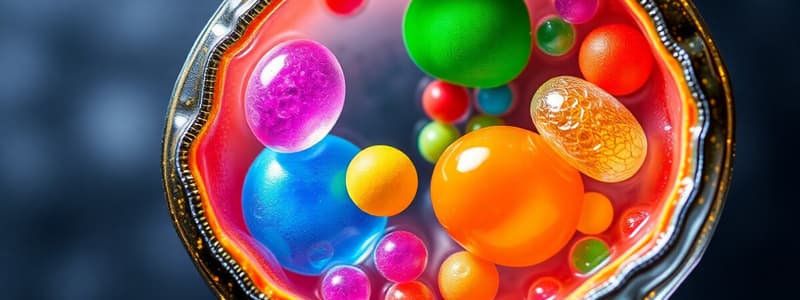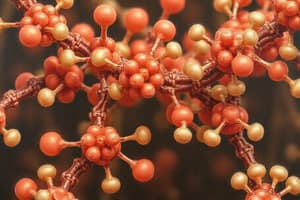Podcast
Questions and Answers
What is a cell?
What is a cell?
The most basic structural and functional unit of life; the smallest part of an organism that is still capable of all life's processes.
What is an organelle?
What is an organelle?
Specialized structures within the cell that work together to help the cell function.
What is a macromolecule?
What is a macromolecule?
Key large biological molecules that make up all living things.
What is a nucleotide?
What is a nucleotide?
What is a fatty acid?
What is a fatty acid?
What is a monosaccharide?
What is a monosaccharide?
What is an amino acid?
What is an amino acid?
What is an enzyme?
What is an enzyme?
What is a catalyst?
What is a catalyst?
What is an active site?
What is an active site?
What is differentiation?
What is differentiation?
Which of the following are characteristics that all living things share? (Select all that apply)
Which of the following are characteristics that all living things share? (Select all that apply)
What role does the cell membrane play?
What role does the cell membrane play?
The mitochondria are the site of _______.
The mitochondria are the site of _______.
What is the structure of the cell membrane?
What is the structure of the cell membrane?
What is the importance of carbohydrates in the human body?
What is the importance of carbohydrates in the human body?
What is the relationship between DNA, chromosomes, and genes?
What is the relationship between DNA, chromosomes, and genes?
What is the cell cycle?
What is the cell cycle?
What does 'form dictates function' mean?
What does 'form dictates function' mean?
List the levels of organization within an organism.
List the levels of organization within an organism.
What is a cell?
What is a cell?
What is an organelle?
What is an organelle?
What is a macromolecule?
What is a macromolecule?
What is a nucleotide?
What is a nucleotide?
What is a fatty acid?
What is a fatty acid?
What is a monosaccharide?
What is a monosaccharide?
What is an amino acid?
What is an amino acid?
What is an enzyme?
What is an enzyme?
What is a catalyst?
What is a catalyst?
What is an active site?
What is an active site?
What is differentiation?
What is differentiation?
List the characteristics that all living things share.
List the characteristics that all living things share.
What is the role of the cell membrane?
What is the role of the cell membrane?
What are ribosomes responsible for?
What are ribosomes responsible for?
What occurs during the S phase of interphase?
What occurs during the S phase of interphase?
What is mitosis?
What is mitosis?
Explain the phrase 'form dictates function'.
Explain the phrase 'form dictates function'.
Identify the levels of organization within an organism.
Identify the levels of organization within an organism.
Flashcards are hidden until you start studying
Study Notes
Vocabulary
- Cell: The essential unit of life, capable of all biological processes.
- Organelle: Specialized structures within cells collaborating to maintain functionality.
- Macromolecule: Large biological molecules vital for life, including proteins, lipids, carbohydrates, and nucleic acids.
- Nucleotide: The basic building block of nucleic acids.
- Fatty Acid: The fundamental component of lipids.
- Monosaccharide: The simplest form of carbohydrates; a single sugar unit.
- Amino Acid: The building blocks of proteins.
- Enzyme: Proteins that catalyze biochemical reactions, increasing reaction rates.
- Catalyst: Compounds that accelerate biochemical reactions by reducing activation energy.
- Active Site: Specific region on an enzyme where substrates bind.
- Differentiation: Process where stem cells develop into specialized cell types.
Characteristics of Living Things
- Composed of cells.
- Respond to environmental stimuli.
- Capable of growth and reproduction.
- Use energy through metabolism.
- Contain genetic material (DNA or RNA).
- Adapt to changing environments.
Role of Organelles
- Cell Membrane: Regulates entry and exit of substances.
- Centrioles: Essential for cell division; organize spindle fibers.
- Cilia: Move fluids across cell surfaces.
- Flagella: Propel the entire cell through fluids.
- Nucleus: Stores genetic material and controls cellular activities.
- Ribosomes: Sites of protein synthesis.
- Rough ER: Synthesizes proteins.
- Smooth ER: Involved in lipid production and storage; modifies chemicals.
- Golgi Apparatus: Modifies and packages proteins for transport.
- Vesicles: Transport materials within and outside of the cell.
- Lysosomes: Digestive organelles that break down waste.
- Vacuoles: Function in storage, typically of nutrients or waste.
- Mitochondria: Powerhouse of the cell; site of cellular respiration.
Cell Membrane Structure
- Composed of two phospholipid layers with polar hydrophilic heads and nonpolar hydrophobic tails.
- Embedded carbohydrates provide structural support and signaling functions.
- Proteins serve as channels for transport and for signaling purposes.
- Selective permeability allows small, nonpolar molecules and water to pass freely, while polar and large molecules require specific channels or vesicles for transport.
Importance of Macromolecules
- Carbohydrates: Serve as energy storage and structural molecules; key for signaling.
- Lipids: Store energy, provide cell membrane structure, and offer insulation/protection.
- Nucleic Acids: Encode genetic information; guide protein synthesis.
- Proteins: Support diverse functions, including enzymatic reactions, signaling, transport, and structural roles.
DNA, Chromosomes, and Genes
- DNA encapsulates all genetic information, organized in 46 chromosomes per cell.
- Each chromosome contains thousands of genes that instruct protein synthesis.
- Proteins facilitate and regulate bodily processes.
Role of Enzymes
- Enzymes act as biological catalysts, enhancing reaction rates while being substrate-specific.
- Each enzyme is tailored to bind distinctly with its substrate, regulating biochemical reactions.
Levels of Organization
- Ranges from most complex to simplest: Organism, organ systems, organs, tissues, cells.
Cell Cycle Overview
- Interphase: Most prolonged stage, with critical S phase for DNA synthesis ensuring identical chromosomes in daughter cells.
- Mitosis: Comprises Prophase, Metaphase, Anaphase, and Telophase; responsible for chromosome segregation.
- Cytokinesis: Final step dividing the cytoplasm into two identical daughter cells.
Form Dictates Function
- Structure determines function; the anatomy of cells, organs, and systems aligns with their physiological roles.
- Analyzing structures reveals how they contribute to overall bodily functions.
Organelles Identification
- Ability to identify organelles through diagrams or descriptions of their structures.
Function-Specific Organelles
- Essential organelles can be determined based on specific cellular functions described.
Organization Levels Application
- Ability to arrange body organization levels from smallest to largest and vice versa.
Vocabulary
- Cell: The essential unit of life, capable of all biological processes.
- Organelle: Specialized structures within cells collaborating to maintain functionality.
- Macromolecule: Large biological molecules vital for life, including proteins, lipids, carbohydrates, and nucleic acids.
- Nucleotide: The basic building block of nucleic acids.
- Fatty Acid: The fundamental component of lipids.
- Monosaccharide: The simplest form of carbohydrates; a single sugar unit.
- Amino Acid: The building blocks of proteins.
- Enzyme: Proteins that catalyze biochemical reactions, increasing reaction rates.
- Catalyst: Compounds that accelerate biochemical reactions by reducing activation energy.
- Active Site: Specific region on an enzyme where substrates bind.
- Differentiation: Process where stem cells develop into specialized cell types.
Characteristics of Living Things
- Composed of cells.
- Respond to environmental stimuli.
- Capable of growth and reproduction.
- Use energy through metabolism.
- Contain genetic material (DNA or RNA).
- Adapt to changing environments.
Role of Organelles
- Cell Membrane: Regulates entry and exit of substances.
- Centrioles: Essential for cell division; organize spindle fibers.
- Cilia: Move fluids across cell surfaces.
- Flagella: Propel the entire cell through fluids.
- Nucleus: Stores genetic material and controls cellular activities.
- Ribosomes: Sites of protein synthesis.
- Rough ER: Synthesizes proteins.
- Smooth ER: Involved in lipid production and storage; modifies chemicals.
- Golgi Apparatus: Modifies and packages proteins for transport.
- Vesicles: Transport materials within and outside of the cell.
- Lysosomes: Digestive organelles that break down waste.
- Vacuoles: Function in storage, typically of nutrients or waste.
- Mitochondria: Powerhouse of the cell; site of cellular respiration.
Cell Membrane Structure
- Composed of two phospholipid layers with polar hydrophilic heads and nonpolar hydrophobic tails.
- Embedded carbohydrates provide structural support and signaling functions.
- Proteins serve as channels for transport and for signaling purposes.
- Selective permeability allows small, nonpolar molecules and water to pass freely, while polar and large molecules require specific channels or vesicles for transport.
Importance of Macromolecules
- Carbohydrates: Serve as energy storage and structural molecules; key for signaling.
- Lipids: Store energy, provide cell membrane structure, and offer insulation/protection.
- Nucleic Acids: Encode genetic information; guide protein synthesis.
- Proteins: Support diverse functions, including enzymatic reactions, signaling, transport, and structural roles.
DNA, Chromosomes, and Genes
- DNA encapsulates all genetic information, organized in 46 chromosomes per cell.
- Each chromosome contains thousands of genes that instruct protein synthesis.
- Proteins facilitate and regulate bodily processes.
Role of Enzymes
- Enzymes act as biological catalysts, enhancing reaction rates while being substrate-specific.
- Each enzyme is tailored to bind distinctly with its substrate, regulating biochemical reactions.
Levels of Organization
- Ranges from most complex to simplest: Organism, organ systems, organs, tissues, cells.
Cell Cycle Overview
- Interphase: Most prolonged stage, with critical S phase for DNA synthesis ensuring identical chromosomes in daughter cells.
- Mitosis: Comprises Prophase, Metaphase, Anaphase, and Telophase; responsible for chromosome segregation.
- Cytokinesis: Final step dividing the cytoplasm into two identical daughter cells.
Form Dictates Function
- Structure determines function; the anatomy of cells, organs, and systems aligns with their physiological roles.
- Analyzing structures reveals how they contribute to overall bodily functions.
Organelles Identification
- Ability to identify organelles through diagrams or descriptions of their structures.
Function-Specific Organelles
- Essential organelles can be determined based on specific cellular functions described.
Organization Levels Application
- Ability to arrange body organization levels from smallest to largest and vice versa.
Studying That Suits You
Use AI to generate personalized quizzes and flashcards to suit your learning preferences.




